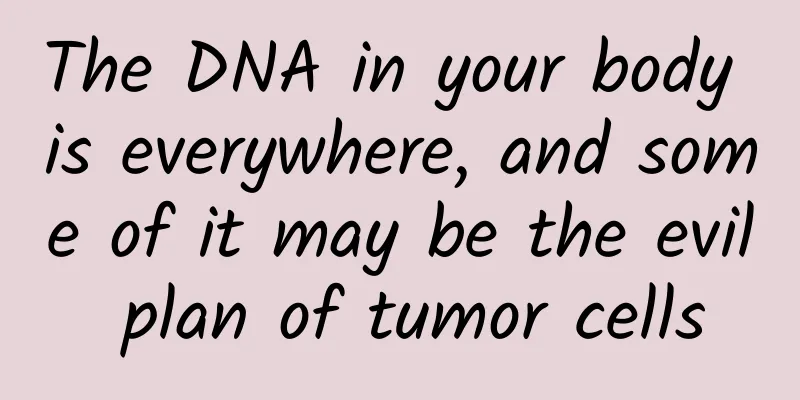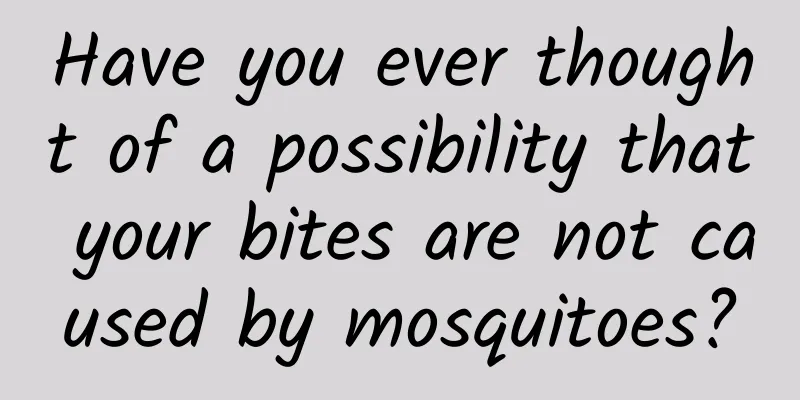The DNA in your body is everywhere, and some of it may be the evil plan of tumor cells

|
Author: Liu Tiantong Tsinghua University School of Medicine Editor|Chen Tianzhen DNA is a really strange thing, it is everywhere, in the air, in the water, and even in the human body. We know that chromosomes in the cell nucleus carry DNA, which is the complete set of genetic material necessary for our growth and development. Students who are good at high school biology also know that mitochondria have their own set of DNA. In addition to this? Biologists have also isolated DNA from various sources: Where do these DNAs come from? Are they drafts typed out when chromosome DNA is replicated? Or are they DNA compatriots who lost their way in the vast cells? Although scientists do not have a definite answer to this, some studies have found that many of them are closely related to cancer. Free tumor DNA: a relic of tumor cells? We usually think that DNA, as the genetic material of the human body, should stay in the cells. However, research has found that almost all types of cells in our body release DNA to the outside of the cell in some way, either passively during cell aging and death, or actively "spitting" it out. They are free in the blood and other body fluids, so they are called free DNA. In tumor patients, the part of free DNA that comes from tumor cells is called free tumor DNA. Tumor cells release free tumor DNA (ctDNA) into the blood. |mycancergenome.org These DNAs are usually very short, containing only 50 to 200 deoxynucleotides, and are completely incapable of being expressed as proteins. After sequencing these DNAs, scientists found that almost every DNA segment in the genome is present in these fragmented free DNAs, just like there is a pair of boring scissors in our body, which cuts the extremely long genomic DNA into segments. Why do our bodies produce these short free DNAs? Is it some unknown force deliberately messing with it? We know that the essence of tumor formation is gene mutation: as people age, the number of DNA replications in cells increases, gene mutations accumulate over time, and eventually cause tumors. Various studies have confirmed that more free DNA can be detected in the elderly and patients with various diseases. Due to the vigorous growth and rapid renewal of tumor cells, the free DNA in the blood of tumor patients is several times higher than that of ordinary people, and mainly comes from the genome of necrotic or apoptotic tumor cells. These evidences show that free DNA is closely related to cancer. So theoretically, we can just draw a tube of blood and test the characteristics of these DNAs to obtain some characteristics of the tumor itself to a certain extent, such as tumor stage, mutations carried by the tumor, the effect of anti-tumor treatment, whether there is recurrence after surgery, etc. At present, similar applications are still in the basic research stage. If they are applied clinically in the future, they will become a highly cost-effective auxiliary examination method in the process of tumor treatment. Detecting free tumor DNA can help understand the characteristics of tumor cells. | Source: Oxfordglobal Off topic: At this point, we have to mention the rumor that "Shocking, a drop of blood can detect whether you have cancer." It can be said that with just a few words, it has solved all the problems of tumor screening, which is amazing and exciting. However, after calming down, scientists had to use ten times the energy and effort to dispel this rumor. It is not impossible to detect tumors through blood, but at least at this stage, its application is still very limited. How the media reports science Extrachromosomal DNA: The evil plan of tumor cells In addition to free DNA, there is also extrachromosomal DNA. As the name suggests, extrachromosomal DNA is a DNA molecule independent of the chromosomal DNA in the cell nucleus. They mainly appear in tumor cells and are likely to be the evil plans of tumor cells. Normally growing cells are like a car that drives normally, slowing down at a red light and accelerating at a green light. When cells become cancerous, they are usually accompanied by two important characteristics: the activation of oncogenes and the inactivation of tumor suppressor genes. The activation of oncogenes is like stepping on the accelerator pedal, which accelerates the growth and proliferation of cells. Fortunately, under normal circumstances, there are tumor suppressor genes in the cells, which prevent the car from taking off completely. But if the tumor suppressor genes are inactivated at this time, it will be a big trouble. The accelerator pedal is stepped on the bottom, and the brakes are also out of work. The various defense mechanisms in our body cannot stop the wild growth of cells at all, and malignant tumors may develop at this time. Studies have shown that genes carried by extrachromosomal DNA are basically activated proto-oncogenes. This type of DNA is not easy to appear under normal circumstances, but if the environment in which cells grow changes dramatically, such as when anti-tumor drugs or radiation are used, it will stimulate their production. Once tumor cells produce extrachromosomal DNA, it is like a car that has been put into climbing gear. Even if there are dangers ahead, it can still accelerate uphill like crazy, promoting tumor cell proliferation. What is more troublesome is that within the same tumor, some tumor cells produce more extrachromosomal DNA, while others produce less or almost none, which results in a mixed bag of cells inside the tumor, with different speeds, making it difficult to handle. Therefore, if there is a way to selectively inhibit and eliminate extrachromosomal DNA, it may be possible to inhibit the growth of tumor cells to a certain extent. Extrachromosomal DNA under electron and fluorescence microscopes. | Source: BOUNDLESS BIO/TheScientist DNA therapy: a new approach to cancer treatment Although our bodies have barriers that help eliminate potential tumor cells, and scientists have developed numerous powerful anti-tumor drugs, in many cases, tumor cells always seem to be able to think of ways to deal with it - even if 99% of tumor cells are eliminated, the remaining tiny bits of cells can always hide their light and wait for an opportunity to make a comeback, leading to tumor recurrence and metastasis. From this point of view, tumor cells can be called the tardigrades of the cell world, with extremely tenacious vitality. However, tumor cells are so cunning that drugs are sometimes completely helpless against them. For example, chemotherapy drugs fight tumor cells, just like traffic police arrest speeding vehicles. Tumor cells accidentally step on the accelerator, divide and accelerate, and are immediately handcuffed. What is a headache is that there are always some tumor cells that are very cunning. Not only do they not accelerate, they also step on the brakes. When they encounter a big slope, they don't shift into climbing gear and turn around directly. Professionally speaking, they enter a "dormant state." The result is that the cells inside a malignant tumor all have different temperaments. Some like to drive fast, some drive slowly, and some don't drive at all. It is really difficult to manage them using the same set of rules and regulations. Free tumor DNA and extrachromosomal DNA provide us with new ideas for fighting tumors. By detecting free tumor DNA in the blood, we can further understand the biological characteristics of tumor cells, figure out the temperament of various cells inside the tumor, and speculate which drugs may be effective, so as to choose individualized treatment methods. On the other hand, through targeted targeting and precise attacks on extrachromosomal DNA, it is theoretically possible to discipline tumor cells, make their temperaments more consistent, and thus better control the tumor. Each cell in a malignant tumor has a different temperament. Free tumor DNA and extrachromosomal DNA provide new ideas for fighting tumors. | Science In fact, in addition to our understanding of chromosomes and mitochondrial DNA, we are still trying to isolate DNA from various other sources and trying to understand where these DNAs come from, where they go, their functions and possible applications. We have always believed that chromosomal DNA contains all the information related to individual growth and development, but with the explosive development of biological science, every piece of knowledge in the textbook has the opportunity to be rewritten. The ubiquitous DNA in the body may give us a broader understanding of the DNA world. Reference Chain [1]https://en.wikipedia.org/wiki/Circulating_free_DNA [2]https://academic.oup.com/clinchem/article/66/6/754/5848613 [3]https://www.ncbi.nlm.nih.gov/pmc/articles/PMC7168519/pdf/nihms-1067253.pdf |
<<: If you don’t read this skiing knowledge article, Gu Ailing will have won all the gold medals!
>>: Epic moves! How difficult is the 4A challenged by Yuzuru Hanyu? 4.5 turns in one second...
Recommend
How much does it cost to attract investment through the Heihe Hotel Mini Program? What is the investment price of Heihe Hotel Mini Program?
How much does it cost to attract investment throu...
Sohu account, Baijia account, which platform is the most suitable for self-media people?
Self-media has become a common model for personal...
How much does it cost to develop a Hefei fabric mini program?
How much is the quotation for Hefei fabric develo...
Is it not because of the cold that we exhale white air in winter? There is no white air in Antarctica!
The temperature has dropped continuously in recen...
Insights into female marketing trends!
With the development and penetration of mobile In...
Promotional event: the process of bargaining for popular products!
As early as 2016, price-cutting reached a small c...
I'm tired of waiting and found out that iOS 9.2 beta4 is the official version
After 3 weeks of waiting, we finally welcomed the...
How to play the second type of e-commerce information flow advertising!
When the Internet becomes a traditional industry,...
The most popular Windows phone Lumia 520 has been completely upgraded with Android 7.1
Recently, an XDA expert showed that he successful...
What benefits can WeChat Mini Programs bring to businesses?
Nowadays, mini programs are becoming a product th...
What is the push mechanism of Tik Tok? How does Tik Tok get traffic?
In today's Internet age, traffic is the most ...
[Case] How to use popular topics such as Father’s Day for App marketing promotion?
June 19th, the third Sunday in June, is Father’s ...
Mars and the Beehive Cluster will have a close encounter in the western sky tonight. It's worth seeing.
June 2 Mars will "meet" with the Beehiv...
Tencent advertising placement tips for the securities industry!
After the outbreak of the epidemic in 2020, the s...
Don’t say “freezing like a dog” when the temperature drops. This is a bit unfair to dogs…
As the weather in the northern hemisphere gets co...









